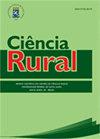巴西Goiás州口蹄疫风险分级的多标准分析模型
IF 0.9
4区 农林科学
Q3 AGRONOMY
引用次数: 0
摘要
摘要:口蹄疫(FMD)是一种影响多种动物的病毒性疾病,包括家畜和野生动物。口蹄疫疫情的发生可能对国家或地区的畜牧生产和经济造成巨大的负面影响。几十年来,大规模群体疫苗接种一直是控制该病的主要策略。然而,各国正在开始根除口蹄疫的阶段,这涉及暂停疫苗接种。本研究通过评价和综合涉及口蹄疫传入和传播的多种危险因素,对巴西Goiás州口蹄疫发生风险进行了分类。收集了126345处农村房产的数据,并按城市分类。将危险因素分为两个模块,通过对危险因素的相加和加权得到每个模块的得分。这些综合得分产生最终的口蹄疫发生风险评分。大多数城市以及畜群的可能性最低。与畜群密度和动物运动相关的变量在得分构成中起关键作用。我们相信,该模型可以成为与消灭口蹄疫有关的行动和战略决策过程中的有用工具。本文章由计算机程序翻译,如有差异,请以英文原文为准。
Multicriteria analysis model for foot-and-mouth disease risk classification in the state of Goiás - Brazil
ABSTRACT: Foot-and-mouth disease (FMD) is a viral disease that affects several animal species, including domestic and wildlife ones. The occurrence of an FMD outbreak can potentially cause a large negative impact on countries or regions’ livestock production and economy. Performed over several decades, mass herd vaccination has been the main strategy to control the disease. However, countries are beginning the stage of eradicating FMD, which involves suspending vaccinations. The present study carried out a risk classification for FMD occurrence in Goiás State, Brazil by evaluating and combining multiple risk factors involved in FMD introduction and dissemination. Data from 126,345 rural properties were collected and categorized by municipality. The risk factors were grouped into two modules and then scores for each module were obtained by adding and weighting the risk factors. These combined scores resulted in the final FMD occurrence risk score. Most of the municipalities, as well as the herds were found in the lowest likelihood levels. Variables linked to herd density and animal movement played a key role in the score composition. We believed that this model can be a useful tool in the decision-making process regarding actions and strategies related to FMD eradication.
求助全文
通过发布文献求助,成功后即可免费获取论文全文。
去求助
来源期刊

Ciencia Rural
AGRONOMY-
CiteScore
1.70
自引率
0.00%
发文量
233
审稿时长
2-4 weeks
期刊介绍:
The purpose of Ciência Rural is to publish the results of original research, note and reviews which contribute significantly to knowledge in Agricultural Sciences. Preference will be given to original articles that develop news concepts or experimental approaches and are not merely repositories of scientific data. The decison of acceptance for publication lies with the Editors and is based on the recommendations of Editorial Comission, Area Committee and/ or ad hoc reviewers. The editors and reviewers are external to the institution.
 求助内容:
求助内容: 应助结果提醒方式:
应助结果提醒方式:


